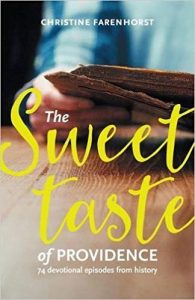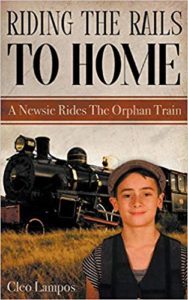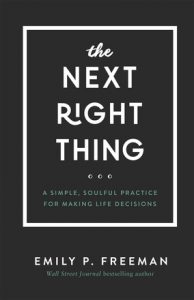I have been reading The Sweet Taste of Providence for well over a year. Last winter it was beside my fireside chair. A few times a week I would pick it up, read a story, and then ponder it, knitting thoughtfully. During the busy gardening season it sat on my bookshelf, and recently I took it down again. Inspiring, consoling, and a safe place for adults to consider the deepest questions of life, this would also be a wonderful book for homeschooling. I wish it had been around when my children were younger, and I am sharing tidbits with them now in the hope that they will read it on their own.
“History is like a large, beautiful cake. We can cut it into wonderful slices of providence, feast on them piece by piece, and be fed. The stories within this book are such slices.”
These words, on the back cover of The Sweet Taste of Providence, describe the book, its purpose, and its effects precisely. Christian Farenhorst, author of many historical books, has written 74 very short stories for this historical devotional. Each one leads the reader to reflect, in some way, on God’s grace, and discussion questions help with this.
Most of the stories are suitable for ages 8 to adult. Some of them may be too emotional for little ones, though. Life is rarely easy, and God’s people often face especially difficult times. This is good for all of us—including little ones, eventually— to realize. (The somewhat popular idea that good Christians have easy lives is contradicted by any study of history.) Yet it is also important for us all to realize that God cares for us lovingly even in the hard times, and Farenhorst reminds her readers of this over and over.
The stories in The Sweet Taste of Providence are about all sorts of people—old and young, famous and unknown, good and bad. Christine Farenhorst writes about Jonathan Swift’s prank, Elizabeth I’s toothache, conscience money, Diana of Poitiers, the stuffed mouse and Charlemagne, Reverend Smytegelt and the angels, Blondin the tightrope walker, Miss X of Bristol, the Bishop of Lichfield and lying, the architect of the Colosseum, Dwight Moody, and many more. Some of the vignettes are happy, some are sad; some have clear and obvious morals and others leave one thinking; some talk about our lives and others point to Jesus. These stories bring us both encouraging heroes of the faith and sad examples of lives without God.
Open-ended questions, two per story, can lead to personal reflection or lively discussions; so can the Bible text at the beginning of each story. Although the discussion questions are geared to older people, they can be adapted for children.
Farenhorst ends the book with a pointed poem about Jonah Brown and the Great Commission:
…Statistics say and facts construe,
That many vessels have a queue
Of Jonahs anxious to board on,
To leave their calling and be gone
…
Yet through Christ’s grace, his great command
Vomits our presence on dry land,
And bids us walk our streets with dread
Leaving no prophecy unsaid.
These few lines say enough: once again we taste the sweet providence that reminds us of a responsibility Satan would have us forget.
In a Christian culture that speaks mostly of God’s love, Farenhorst’s tales and discussion questions remind us that we deserve God’s wrath and that that his love and care are pure grace. They also show that God’s love is not about making us comfortable but often involves difficult obedience or even suffering.
The Sweet Taste of Providence is an inspiring tool parents can use as they speak with their children and teens about the Lord. Although it does present great insight into everyday life throughout history, this is not a systematic book for history study. Rather it is a devotional look at historical individuals; it could easily lead to further historical exploration, but that is not necessary.
The whole family can enjoy and be blessed by this book. It is a unique devotional, a great read aloud, a helpful discussion starter for older children, teens and adults, and an effective supplement to history studies.
—
Christine Farenhorst has written many books about history; I have previously reviewed Katharina Katharina.
—
For more information about studying history from a Christian point of view, see my review of A Little Book for New Historians. I have also discussed the modern approach to studying history, a literature-based approach to Canadian history, and how one can give high school history credit for a literature-based history course.
—
If you enjoyed this review, you might want to connect with me on GoodReads where I eventually share what I read or friend me on Facebook where I occasionally show up.
Disclosure:I received a review copy of The Sweet Taste of Providence from the author and Sola Scriptura Ministries International. I am not compensated for providing my honest opinions.
This post may be linked to Booknificent Thursdays, 52 Books in 52 Weeks Challenge, Literacy Musings Monday, and The Book Nook as well as to Inspire Me Monday, Homemaking Linkup, Friendship Friday.




